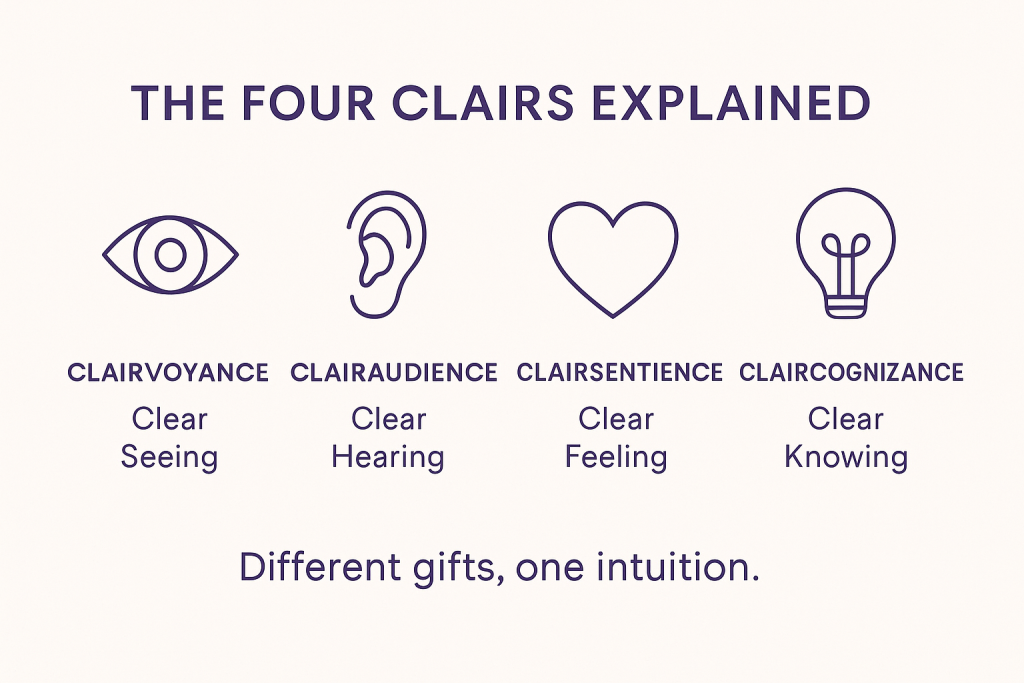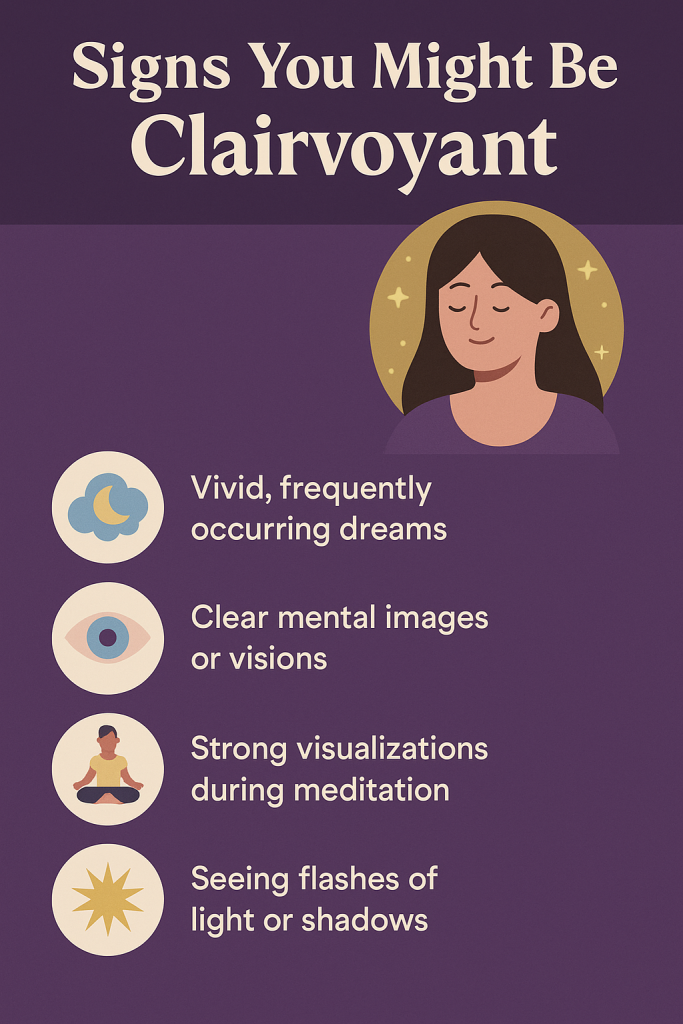Have you ever seen something in your mind’s eye before it happened—an image, a flash of color, a feeling that turned into fact? Maybe you pictured a friend calling moments before your phone lit up. Or you dreamt of a place you had never visited and later found yourself standing there. Those aren’t coincidences; they might be signs that you’re clairvoyant.
Clairvoyance simply means “clear seeing.” It’s the psychic ability to perceive beyond the physical—visions, symbols, or impressions that reveal deeper truths. Yet many people mistake these intuitive glimpses for imagination or luck. This article aims to change that.
In today’s world, clairvoyance is not about crystal balls or movie-style premonitions. It’s about sensitivity to energy, an inner screen that receives guidance from a higher frequency. Some call it intuition. Psychics call it energetic sight.
The goal of this article is to help you recognize whether you have clairvoyant tendencies, understand how they work both scientifically and spiritually, and learn to develop your gift safely and joyfully. We’ll explore modern research on intuition, real-world examples, and practical psychic exercises that strengthen your inner vision—so you can trust what you see, even when no one else does.
What Clairvoyance Really Means in Today’s World
The word clairvoyance comes from the French clair (clear) and voir (to see). But this “seeing” doesn’t always happen with your eyes—it happens with your consciousness. It’s an ability to perceive energies, symbols, or flashes of insight that reveal what logic alone can’t explain.
Clairvoyants don’t just predict the future; they perceive truth in multiple dimensions: past, present, and possible outcomes. For instance, a clairvoyant might see colors swirling around someone (their aura), or visualize a bridge symbolizing reconciliation, or sense a location where an event once occurred.
According to Verywell Mind, intuition is a real psychological process—a rapid integration of subconscious information. From a psychic viewpoint, clairvoyance simply expands that ability into subtler energetic realms.
The clairvoyant spectrum often includes:

Clairvoyance (clear seeing) – Visual intuition
Clairaudience (clear hearing) – Intuitive messages as sound or inner voice
Clairsentience (clear feeling) – Emotional or physical sensations
Claircognizance (clear knowing) – Spontaneous insight
Most people have one or more of these “clairs,” but clairvoyance stands out because it translates energy into visual form. It’s intuition with imagery.
A clairvoyant once joked, “It’s like psychic Netflix—except you don’t get to choose the show, and there are no subtitles.”
The Science and Spirituality Behind Clairvoyance
Clairvoyance bridges two fascinating worlds: neuroscience and spirituality.
Modern science acknowledges that the brain constantly gathers subtle data—tiny visual, auditory, and emotional cues we aren’t consciously aware of. When these merge, they create what psychologists call intuitive perception.
Researchers also note the role of the pineal gland, often referred to in spiritual traditions as the “third eye.” The pineal gland regulates circadian rhythms and produces melatonin, but metaphysical teachings see it as a gateway to higher awareness. Studies like Physiology of the Pineal Gland – NCBI explore how this gland interacts with light and imagery—two elements central to clairvoyant experience.
In spiritual language, the pineal gland acts like a lens between physical and energetic reality. When balanced, it translates intuition into symbolic vision—colors, scenes, or flashes of movement.
For example, a clairvoyant might “see” a soft golden glow around a friend before they share good news. Or they may visualize a storm cloud before a conflict arises. These aren’t literal weather patterns—they’re energetic metaphors.
As Psychology Today explains, intuition isn’t magical thinking; it’s the brain’s ability to connect vast bits of information instantly. Clairvoyance is that mechanism, expanded and energetically fine-tuned.
Signs You Might Be Clairvoyant

How do you know if you’re clairvoyant? Look for these patterns—many people have them without realizing their psychic nature.
You have vivid mental imagery. Your imagination feels alive, colorful, or cinematic.
You receive spontaneous visual flashes. Scenes or colors appear in your mind without effort.
You experience symbolic dreams. Your dreams often predict or mirror future events.
You sense energy visually. You might see auras, lights, or subtle movements others miss.
You daydream solutions that work. You visualize outcomes before taking action.
You recall details others forget. Visual memory is your superpower.
You sense spiritual presence. You may catch glimpses of light or shadows around people or spaces.
An artist once told me she started painting abstract visions she saw during meditation—clouds of violet and silver. Her clients later told her the colors matched their own energy during healing sessions. That’s clairvoyance in action: art as intuitive translation.
According to PMC’s Pineal Research Review, visualization activates neural pathways linked to perception and memory. Psychics would say: your “seeing” muscles are being used on both sides—spiritual and physical.
Clairvoyance vs. Imagination – How to Tell the Difference
One of the biggest struggles for developing clairvoyants is distinguishing between imagination and intuitive vision. The line between them can feel blurry—but the energy behind them is completely different.
Imagination usually starts with intention. You try to visualize something. You “decide” to see an image. Clairvoyance, on the other hand, happens spontaneously. It’s uninvited yet precise. The message appears complete, without your ego shaping it.
Think of it like this: imagination is a movie you direct; clairvoyance is a film that suddenly plays on its own.
Here’s how to tell them apart:
Imagination feels active and emotional. You’re trying to see it.
Clairvoyance feels quiet, neutral, and brief—but it sticks in your memory.
Imagination fades under doubt.
Clairvoyance persists even when you question it.
You can practice discernment with a simple exercise: write down three visual impressions that come to you during the day. Don’t analyze them. After a week, check which ones had meaning or came true. You’ll start recognizing the distinct “texture” of real visions—calm, detached, but strikingly accurate.
A psychic once said, “Truth glows differently than thought.” She meant that intuitive imagery carries a frequency—a hum of certainty that’s impossible to miss once you learn its sound.
How Clairvoyance Develops Over Time
Clairvoyance is not an instant download. It develops through patience, grounding, and curiosity. The more you trust your subtle perceptions, the stronger they grow. Doubt dims the channel; attention sharpens it.
At first, your visions may appear as flashes—colors, quick scenes, or shapes. Over time, they form fuller impressions. Clairvoyants often describe this process like tuning a radio. When the mind is cluttered with stress, the signal becomes static. When calm, images flow smoothly.
Healing your emotional body plays a huge role in expanding clairvoyance. Grief, trauma, or anxiety can cloud your psychic lens. As you heal, your third eye—located between the eyebrows—begins to open.
One mother shared that after losing her son, she started seeing his favorite color blue appearing in random places—candles, signs, even a blue feather on her doorstep. She later realized it was his way of saying hello. Her grief had cracked her spiritual lens wide open.
A Cleveland Clinic study highlights how meditation reduces stress and increases neural connectivity—conditions ideal for intuitive perception. The calmer your mind, the clearer your sight.
To nurture your clairvoyance:
Practice meditation that includes color visualization.
Keep a dream journal and record vivid imagery.
Limit overstimulation—turn off screens before bed.
Eat grounding foods and hydrate often.
Trust that your inner eye sees at its own pace.
Clairvoyance isn’t about effort; it’s about allowance. You don’t force visions—you receive them.
Common Myths About Clairvoyance
Clairvoyance has long been surrounded by myths that make people doubt their own abilities. Let’s clear up a few of the biggest misconceptions.
Myth 1: Clairvoyants see full-blown visions like a movie.
Reality: Most clairvoyant messages are symbolic or metaphorical—like snapshots or colors, not cinematic scenes.
Myth 2: Clairvoyance only predicts the future.
In truth, clairvoyants often see the most probable outcome based on current energy, but free will can change it. It’s not fixed fate—it’s energetic forecasting.
Myth 3: Only gifted people can be clairvoyant.
Clairvoyance is part of human intuition. Some people are born more sensitive, but everyone can develop it through mindfulness and awareness.
Myth 4: Opening the third eye is dangerous.
Fear stems from misunderstanding. Clairvoyance is simply heightened perception. Grounding and self-care prevent overwhelm.
A PsychicOz reader once laughed about this myth: “If third eyes caused chaos, I’d need psychic sunglasses.” The truth is, awareness doesn’t cause harm—resisting it does.
Many beginners expect clairvoyance to feel mystical and otherworldly, but most of the time it’s practical and supportive. It helps you make better decisions, sense truth in relationships, and find creative inspiration.
How to Strengthen Your Clairvoyant Abilities
Once you recognize your clairvoyant potential, the next step is to strengthen it with consistent, gentle practice. Developing psychic sight is like training a muscle—it responds to patience, relaxation, and repetition, not pressure or perfectionism.
1. Meditation with Visualization
Choose a quiet space. Close your eyes and picture a candle flame in your mind. Keep it steady for 60 seconds. Each time your focus wanders, bring it back. This simple act strengthens your inner eye and helps separate imagination from intuitive flashes.
2. Third Eye Chakra Activation
Lightly touch the space between your eyebrows and breathe into it. Imagine indigo light swirling there. Affirm softly, “I see truth clearly.” Avoid forcing images. True clairvoyance feels gentle and effortless, like a breeze moving through your awareness.
3. Journaling Visual Impressions
Every time you see an image, color, or dream that feels meaningful, record it without judgment. Over time, patterns will emerge. The more you notice these links, the stronger your psychic confidence becomes.
4. Crystal Support
Clairvoyants often work with crystals that amplify clarity. Keep amethyst near your meditation space for protection, lapis lazuli for insight, and clear quartz for focus. Crystals don’t “create” psychic power—they help you tune into frequencies that are already yours.
5. Grounding and Energy Detox
The clearer your aura, the sharper your visions. Take salt baths weekly or walk barefoot in nature to discharge static energy. Drink plenty of water. Clarity thrives in calm, hydrated systems.
A PsychicOz reader once shared that her visions grew stronger when she spent time painting outdoors. She realized her clairvoyance wasn’t just spiritual—it was creative. By letting her inner eye play instead of perform, her images flowed naturally.
How Psychics Use Clairvoyance in Readings
Clairvoyance in professional readings is more than prediction—it’s translation. A psychic translates visual energy into language, helping clients understand what their higher self already knows.
During a session, a clairvoyant might “see”:
A door opening, symbolizing opportunity or new beginnings.
A bridge, indicating reconciliation.
Storm clouds, representing emotional tension that needs clearing.
One PsychicOz clairvoyant described seeing soft golden light surrounding a client when speaking about her late father. She explained that the color gold often signals spiritual presence and peace. The client later confirmed she had been asking for a sign from him that morning.
This is how clairvoyance works—it bridges heart and symbol, emotion and imagery. It offers insight beyond words.
Clairvoyants combine their vision with emotional empathy and clear communication. They often journal their imagery after sessions, noticing recurring archetypes like rivers (flow), mirrors (truth), or birds (freedom). Over time, every reader builds a personal symbolic vocabulary that fine-tunes their readings.
Professional clairvoyants also ground after sessions to release client energy and maintain neutrality. That neutrality ensures accuracy—seeing clearly without personal projection.
The Emotional and Spiritual Responsibilities of a Clairvoyant
Seeing beyond illusion comes with responsibility. Clairvoyants handle not only information but energy—and that requires emotional maturity and compassion.
An ethical clairvoyant knows the difference between reading energy and interfering with someone’s free will. They share insights gently, leaving room for choice. A clear message always empowers, never frightens.
To maintain healthy clairvoyant boundaries:
Never read someone without permission.
Cleanse your energy after sessions.
Focus on healing, not proving.
Remain humble—intuition is a partnership with Spirit, not personal control.
A long-time clairvoyant once said, “You’re not the source—you’re the signal tower.” The clearer your frequency, the purer the guidance you transmit.
Clairvoyance also requires emotional regulation. When life feels chaotic, visions can blur. Self-care—rest, laughter, grounding—keeps your perception balanced.
The Verywell Mind article on intuition emphasizes calm awareness as the foundation of trustworthy insight. Psychically, this means your energy must feel peaceful before reading others.
Ultimately, clairvoyance is an act of love—seeing potential, not prediction; energy, not ego.
The Future of Clairvoyance in a Modern World
Clairvoyance is not an ancient relic—it’s a modern skill that’s becoming increasingly relevant in a data-saturated world. As society becomes more digital, people are paradoxically craving inner clarity. Technology gives us information; clairvoyance gives us meaning.
Interestingly, the evolution of artificial intelligence mirrors human intuition. Just as algorithms learn from patterns, clairvoyants read energetic patterns. The difference is that psychics perceive with empathy, guided by spirit instead of code. Both forms of “seeing” depend on sensitivity to subtle signals.
Today, clairvoyance is being integrated into unexpected spaces:
Corporate settings – Intuitive consultants help leaders read emotional energy in teams.
Therapeutic practices – Energy healers use clairvoyant sight to locate emotional blockages.
Creative industries – Artists, designers, and writers use intuitive vision to guide inspiration.
Even social media reflects this shift. People post about “energetic alignment,” “manifesting,” and “trusting signs.” This mainstream language reflects clairvoyant awareness taking cultural root.
In a sense, modern clairvoyance is emotional intelligence at a spiritual frequency. It’s how we sense truth beyond filters and algorithms—how we “see” what can’t be captured by logic alone.
A PsychicOz reader once described this perfectly: “Clairvoyance isn’t escaping reality—it’s zooming out enough to see all of it.”
Conclusion – You Don’t Have to Be a Professional Psychic to See Clearly
Clairvoyance is not limited to psychics or mystics. It lives in everyone who has ever trusted a gut feeling, followed a vision, or recognized a sign meant just for them.
When you stop forcing proof and start observing patterns, life begins to reveal itself visually—through synchronicities, dreams, colors, and timing. You’re not imagining it; you’re remembering how to see energetically.
The moment you acknowledge your clairvoyant sensitivity, it strengthens. Each time you trust your intuition, you polish your inner lens. And as that lens clears, your perception of life changes: people’s motives become transparent, opportunities appear faster, and you begin navigating your path with quiet confidence.
Clairvoyance isn’t about predicting the future—it’s about seeing the truth in the present. The more love and curiosity you bring to it, the clearer it becomes.
So, whether you glimpse colors, sense images, or receive symbols in dreams, know this: you are not “making it up.” You’re waking up.
Your inner vision is already open—it’s just waiting for you to look.
Frequently Asked Questions
1. What does clairvoyance really mean?
Clairvoyance means clear seeing—receiving visual intuitive information as images, symbols, colors, or scenes in the mind’s eye.
2. Is clairvoyance the same as imagination?
No. Imagination is effortful and fades; clairvoyant images arrive spontaneously, feel calm and neutral, and tend to stick.
3. Can anyone develop clairvoyant ability?
Yes. Most people have latent intuitive sight that improves with practice, grounding, and consistent journaling.
4. What are the other “clairs” besides clairvoyance?
Clairaudience (hearing), clairsentience (feeling), and claircognizance (knowing). Many people blend two or more.
5. How do I know if a vision is meaningful?
It repeats, carries a steady feeling-tone, or proves relevant later. Track in a journal and review weekly.
6. What are common signs I might be clairvoyant?
Vivid mental imagery, symbolic dreams, flashes of color, aura sensitivity, and déjà vu with emotional depth.
7. Where do clairvoyant images come from?
From your higher self and subtle energy fields. They’re filtered through your psyche as personal symbols.
8. What is the third eye and how does it help?
It’s a term for inner sight linked to the brow center. Gentle focus and relaxation improve clarity and discernment.
9. How can I start training my inner vision today?
Do a one-minute candle visualization, write down three visual impressions daily, and practice short grounding breaks.
10. Which crystals support clairvoyance?
Amethyst for protection, lapis lazuli for insight, and clear quartz for focus. Use as anchors, not crutches.
11. Can clairvoyance predict the future exactly?
It often shows probable paths based on current energy. Free will and new choices can shift outcomes.
12. Why do symbols appear instead of literal pictures?
Symbols travel faster than words. Your intuition speaks in a visual shorthand your subconscious understands.
13. How do I avoid confusing anxiety with intuition?
Intuition feels brief and calm; anxiety feels loud and looping. Act from the calmest clear sense available.
14. Do I need to meditate for long periods?
No. Consistency beats length. Two to five minutes of focused visualization daily is effective.
15. Are vivid dreams part of clairvoyance?
Yes. Dream imagery is a prime channel for intuitive sight. Record dreams upon waking for accuracy.
16. How do I read my own symbols?
Create a symbol key. For example, bridges may mean reconciliation; doors may mean opportunity. Update over time.
17. What lifestyle habits sharpen clairvoyance?
Good sleep, hydration, reduced digital noise at night, nature time, and reflective journaling.
18. Can strong emotions blur clairvoyance?
Yes. Overwhelm adds static. Ground first, then revisit the vision when you feel settled.
19. Is it okay to do clairvoyant exercises every day?
Yes, if you also ground and rest. Balance practice with integration to avoid fatigue.
20. How do professional psychics use clairvoyance in readings?
They translate images into practical guidance, cross-checking with felt sense and the client’s questions.
21. What’s an easy pre-reading routine?
Three deep breaths, hand on heart, set an intention to see clearly, and briefly scan for calm neutrality.
22. How do I ethically use clairvoyance?
Ask consent, empower choice, avoid fear-based statements, and share insights with compassion and humility.
23. Can clairvoyance help relationships?
Yes. It can illuminate patterns, needs, and timing—supporting honest conversation and aligned decisions.
24. What if I don’t see anything at first?
Start with guided visualization. Noticing even faint colors or shapes counts. Sensitivity grows with attention.
25. Should I share every image I perceive?
No. Sense timing and relevance. Share only what serves clarity and respects boundaries.
26. How do I cleanse energy after practice?
Salt bath or shower visualization, breathwork, gentle stretching, or a short nature walk.
27. Can screens and late-night scrolling dull my sight?
Often. Blue light and mental clutter reduce dream recall and subtle perception. Create a wind-down routine.
28. What journal format works best?
Date, context, the image seen, feeling-tone (1–5 calm scale), and later validation notes.
29. How do I combine logic with clairvoyance?
Use images as hypotheses, then confirm through conversation, research, or small test actions.
30. When should I book a professional psychic reading?
When symbols repeat, choices feel high-stakes, or you want validation and next-step clarity from an experienced reader.





I find it fascinating how the author breaks down the development of clairvoyant abilities from childhood experiences to adult practices. It adds a semblance of structure to something that often feels very abstract.
The advice on maintaining balance and being mindful while practicing clairvoyance is quite pertinent. The psychological aspects mentioned are important for anyone venturing into the spiritual domain.
This article provides an interesting perspective on clairvoyance and how one can develop such psychic abilities. It seems that a lot of emphasis is placed on personal development and practice.
Indeed, the steps mentioned are quite practical. Meditation and trust in one’s intuition are crucial for anyone exploring these abilities.
Engaging with one’s spiritual guides and angels is emphasized repeatedly in this article. It’s intriguing how interpersonal practice is recommended as a means of honing these psychic skills.
The focus on continuous practice and the idea that everyone has the potential to develop these abilities is quite inclusive. It suggests that clairvoyance is not limited to a select few, but accessible to anyone willing to put in the effort.
This article beautifully encapsulates the journey of clairvoyance. The emphasis on development and the practical advice offered is invaluable. It’s inspiring to see such a comprehensive guide that encourages individuals to embrace and cultivate their psychic gifts with love and an open heart. The suggestions for meditation and connecting with spirit guides are particularly insightful. Truly enlightening!
Comments are closed.